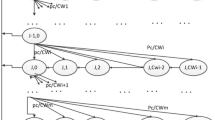Abstract
Distributed queue dual bus (DQDB) has been adopted as the IEEE 802.6 standard for metropolitan area networks (MANs). The access mechanism is based on an implicit distributed queue maintained at each node. DQDB has been shown to achieve maximal aggregate throughput and minimal access delay independent of the size and speed of the network. However, as the size and load of the network increase, DQDB gives rise to throughput unfairness problems due to the long propagation delay. This paper initially presents a survey and assessment of recently proposed remedial DQDB mechanisms. These approaches are categorized as time division multiplexing (TDM)-oriented versus non-TDM-oriented, and exhaustive versus non-exhaustive operations. Regarding TDM as the most promising mechanism, the paper then provides the performance analysis of one TDM-oriented method, called multiple segment control (MSC), proposed by the authors. In the analysis, the network is modelled as a set of identicalM/G/1 queues, each with different services for transmitting the first and remaining segments in a busy period. The average aggregate access delay is then analyzed via an embedded Markov model. The paper shows simulation results to demonstrate the precision of the performance analysis and the performance superiority of MSC over non-TDM-oriented DQDB mechanisms. Furthermore, as will be shown, the network using the TDM-oriented method may incur bandwidth waste should active stations fail. The paper finally proposes a guardian reliability scheme to ensure the robustness of networks.
Similar content being viewed by others
References
Draft proposed standard, distributed queue dual bus (DQDB) metropolitan area network, P802.6/D15 (October 1990).
W.R. Byrne et al., Evolution of metropolitan area networks to broadband ISDN, IEEE Commun. Mag. (January 1991).
B. Goldstein et al., High bandwidth metropolitan area networking architecture, Int. J. Digit. Anal. Cabled Syst. 1(1988)121–127.
C.C. Bisdikian, Waiting time analysis in a single buffer DQDB (802.6) network, IEEE J. Selec. Areas Commun. SAC-8(1990)1565–1573.
M. Conti, E. Gregori and L. Lenzini, A methodological approach to an extensive analysis of DQDB performance and fairness, IEEE J. Selec. Areas Commun. (January 1991).
P. Tran-Gia and Th. Stock, Approximate performance analysis of the DQDB access protocol, Comp. Networks and ISDN Syst. 20(1990)231–240.
M. Kabatepe and K. Vastola, Exact and approximate analysis of DQDB under heavy load,Proc. IEEE INFOCOM'92' (1992) pp. 508–517.
M. Zukerman and P. Potter, The DQDB protocol and its performance under overload traffic conditions, Comp. Networks and ISDN Syst. 20(1990)261–270.
L. Kleinrock,Queueing Sytems, Vol. I:Theory (Wiley, New York, 1975).
H. Santoso and S. Fdida, Protocol evolution and performance analysis of the IEEE 802.6 DQDB MAN,Proc. EFOC/LAN 90 (1990) pp. 226–230.
J. Filipiak, Access protection for fairness in a distributed queue dual bus metropolitan area network,ICC'89 (1989) pp. 635–639.
M.W. Garrett and S. Li, A study of slot reuse in dual bus multiple access networks,INFOCOM'90 (1990) pp. 617–629.
M.A. Rodrigues, Erasure node: Performance improvements for the IEEE 802.6 MAN,INFOCOM'90 (1990) pp. 636–643.
E. Hahhe, A. Choudhury and N. Maxemchuk, Improving the fairness of distributed-queue dual-bus networks,Proc. IEEE INFOCOM'90 (1990) pp. 313–320.
R. Van, Performance evaluation of bandwidth balancing in the DQDB MAC protocol,Proc. EFOC/LAN'90 (1990) pp. 231–239.
M. Ferguson, An overlaod cycle analysis of generalized bandwidth balancing for DQDB,Proc. IEEE INFOCOM'92 (1992) pp. 503–507.
C.W.S. Williams, L.O. Barbosa and N.D. Georganas, System unfairness of DQDB in supporting multiple communities of interest,Proc. IEEE GLOBECOM'91 (1991) pp. 31B.3.1–31B.3.5.
S.Y. Cheung, Controlled request DQDB: Achieving fairness and maximum throughput in the DQDB network,Proc. IEEE INFOCOM'92 (1992) pp. 180–189.
L.N. Kumar and A.D. Bovopoulos, An access protection solution for heavy load unfairness in DQDB,Proc. IEEE INFOCOM'92 (1992) pp. 190–199.
F. Borgonovo et al., Performance of DQDB, a fair MAC protocol for dual bus networks,Proc. IEEE INFOCOM'92 (1992) pp. 210–218.
K.M. Khalil and M.E. Koblentz, A fair distributed queue dual bus access method,Proc. IEEE Local Computer Networks (1989).
M.C. Yuang and H. Chang, A fair and fast DQDB metropolitan area network,Proc. IEEE Local Computer Networks (1991).
M. Kabatepe and K.S. Vastola, FDQ: The fair distributed QUEUE MAN,Proc. IEEE INFOCOM'92 (1992) pp. 200–209.
N.F. Huang and S.T. Sheu, A slot interleaved multiple access scheme for DQDB metropolitan area networks,Proc. IEEE INFOCOM'93 (1993) pp. 1075–1082.
Author information
Authors and Affiliations
Rights and permissions
About this article
Cite this article
Yuang, M.C., Liang, S. Assessment and performance analysis of DQDB MAC protocols. Telecommunication Systems 2, 301–319 (1993). https://doi.org/10.1007/BF02109863
Received:
Revised:
Issue Date:
DOI: https://doi.org/10.1007/BF02109863




